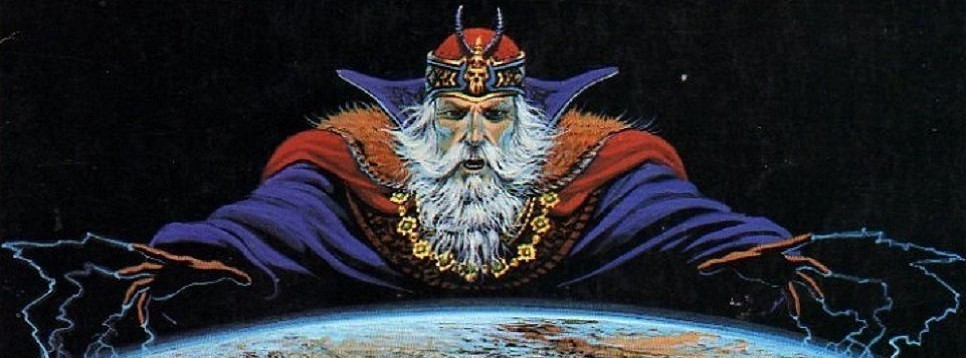


The first version of Dungeons & Dragons initially debuted in 1974. It was published by Tactical Studies Rules, Inc. and designed by Gary Gygax and Dave Arneson. Some consider this to be the first tabletop role-playing game (ttrpg), which set a precedent for all other editions and games to follow. This first edition was heavily inspired by the medieval-themed miniature wargame Chainmail and only had a production budget of $2,000. Looking back, some might find it hard to believe these humble books would become the origin story of a worldwide, multimedia phenomenon.
The original edition also went through major revisions and updates in 1977, 1981, and 1983-1985. Some of these revisions were compiled in 1991, and the final repackaging, titled The Classic Dungeons & Dragons Game, was released in 1994. Many of these revisions occurred during other D&D edition releases including Advanced Dungeons & Dragons.
Between 1977 and 1979, an updated version of D&D was released known as Advanced Dungeons & Dragons. This edition had three core rulebooks: the Player's Handbook, the Dungeon Master's Guide, and the Monster Manual. Many future editions of the game had similar three core rule books often with the same titles.


In 1989, a second edition of Advanced Dungeons & Dragons was released. This new edition tried to consolidate the first edition while also introducing new spells, rules, and player character options. Some of these changes included removing demons and devils, which had received negative publicity at the height of the Satanic Panic (see Pop Culture). AD&D 2e had three core rule books with similar names to the first edition and included other expansion books.
In 1977, Tactical Studies Rules, Inc. was aquired by Wizards of the Coast, the company known for publishing the popular tabletop and digital collectable card game Magic the Gathering. This aquisition stopped all revisions to the Original Dungeons & Dragons. Instead, Wizards decided to focus on creating the newest edition of Advanced Dungeons & Dragons. However, second edition sales didn't do as well as first edition, and some suspected the use of "Advanced" in the title scared off new players.
Therefore, when the new edition was released in 2000, it was simply called Dungeons & Dragons third edition. 3e established the dice rules that exist in D&D today known as the D20 System. The D20 System helped simplify many of the actions PCs and monsters take by defaulting success and failure to the roll of a dice. Additionally, 3e added new rules, ways to play, monsters, and more. These changes encouraged players to be tactful in combat and use miniatures and grid maps.



A revision happened to D&D 3e in 2003. These revisions addressed common complaints and concerns players had about third edition. D&D 3.5 improved combat balancing, updated spells, and added new character options. However, all other rules were the same as third edition. That's why this revision was labeled with the half edition number marker. Many people still prefer playing D&D 3e and 3.5e to this day because these editions have the most options for customization.
Wizards of the Coast released the fourth edition of Dungeons & Dragons in 2008. By far, this was the worst received edition of Dungeons & Dragons. Because 3e and 3.5e had so many books, people were frustrated that they had to invest in the new edition material. On top of these concerns, many D&D players loved the rules established in third edition, but the fourth edition completely overhauled the entire game system of Dungeons & Dragons. The core rules were also in more than three books, which required new players to invest even more than they had to in the past.



After receiving feedback on 4e, Wizards of the Coast started working on a new edition. Dungeons & Dragons 5e was released in 2014. D&D 5e was the first edition that went through years of playtesting before releasing official content. This ensured games were balanced and that different rules would work across the world. D&D 5e is the current edition of Dungeons & Dragons.
A big priority for 5e game makers was to make D&D more new player friendly. Because older editions had so many different rules and books, new players struggled to make a character, let alone understand the game system. Playtesting certainly helped establish easy-to-understand rules and simplified the character creation and leveling process. When 5e was released, Wizards released a free PDF of the Basic Rules. Alongside increased references to D&D in popular culture, D&D 5e's focus on being beginner friendly helped the game grow exponentially. As a result, D&D 5e is the most popular edition of Dungeons & Dragons to date.
In August 2022, Wizards of the Coast announced that a new edition of Dungeons & Dragons was in the works: One D&D. The goal is to make the game more accessible. As a result, game makers will prioritize making One D&D backwards compatible, meaning that older edition books can be used with the new One D&D game mechanics.
Alongside the release of new rules, Wizards wants to improve the digital playing experience. Wizards of the Coast started this process by aquiring D&D Beyond, a site with digital versions of D&D 5e books, supplements, and resources. Wizards is also working on a virtual tabletop. This immersive digital experience would let people move minatures and monsters in a 3D space that Dungeon Masters can control, which helps players save money on buying physical maps or character minatures.
One D&D is also prioritizing and encouraging D&D players to give feedback on playtesting material. Playtesting is currently ongoing and is expected to keep going until some time in 2023. One D&D is set to officially release in 2024 just in time for Dungeons & Dragons's 50th Anniversary.
